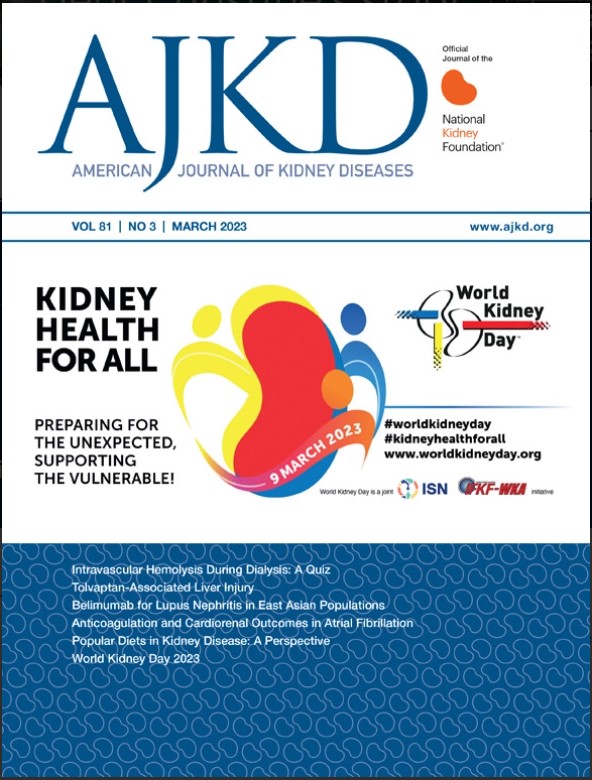Can KDOQI Intervention Rate Target Be Met With Drug-Coated Balloons for Dysfunctional Arteriovenous Fistulas: Post-hoc Analysis of the IN.PACT AV Access Randomized Clinical Trial.
IF 8.2
1区 医学
Q1 UROLOGY & NEPHROLOGY
引用次数: 0
Abstract
RATIONALE & OBJECTIVE A key Kidney Disease Outcomes Quality Initiative (KDOQI) 2019 Vascular Access Guidelines target is to have ≤3 percutaneous or surgical interventions per year to maintain arteriovenous fistula (AVF) patency. We hypothesized first, that the number of interventions to maintain long-term AVF patency conducted in a rigorous clinical trial could be adequately documented and compared against KDOQI targets, and second, that the use of drug-coated balloons (DCB) could reduce the rate of thrombosis and interventions to maintain AVF patency more than standard uncoated balloon angioplasty (PTA). STUDY DESIGN Post-hoc analysis of the IN.PACT AV Access randomized clinical trial. SETTING & PARTICIPANTS Outpatient adult hemodialysis patients with previously matured AVFs that had de novo or non-stented re-stenotic lesions enrolled between April 2017 and May 2018 in the United States, Japan and New Zealand. INTERVENTION Patients were randomized to receive percutaneous transluminal angioplasty with the IN.PACT AV DCB or PTA. OUTCOMES Rate of interventions to maintain access target lesion and access circuit patency and rate of access circuit thrombosis were calculated in both intervention groups and compared against the KDOQI 2019 guideline targets. RESULTS Of the 330 participants randomized, 133 patients completed their 3-year visit. The number of interventions per AVF-year to maintain access circuit patency through 36 months was 1.39 for the DCB group and 1.66 for the PTA group (rate difference -0.28 [-0.47, -0.08]; P = 0.01). The access circuit thrombosis rate was 0.041 in the DCB group and 0.069 in the PTA group (rate difference -0.028 [-0.065, 0.0082]; P=0.1). LIMITATIONS Exclusion of AVF with prior thrombosis and small sample size at 36 months. CONCLUSIONS Both DCB and PTA groups met the KDOQI targets of ≤3 percutaneous or surgical interventions per year to maintain AVF patency. The need for reinterventions to maintain patency and thrombosis rate was reduced with the use of DCB compared with PTA through 36 months. FUNDING None.药物包被球囊对功能障碍动静脉瘘的KDOQI干预率目标能否达到:IN的事后分析PACT AV进入随机临床试验。
理由与目的肾脏疾病结局质量倡议(KDOQI) 2019年血管通路指南的目标是每年进行≤3次经皮或手术干预以维持动静脉瘘(AVF)通畅。首先,我们假设,在严格的临床试验中进行的维持AVF长期通畅的干预措施数量可以充分记录并与KDOQI目标进行比较,其次,使用药物包被球囊(DCB)可以降低血栓形成率,并且干预维持AVF通畅比标准的无包被球囊血管成形术(PTA)更有效。研究设计:IN的事后分析。PACT AV准入随机临床试验。背景和参与者:2017年4月至2018年5月,在美国、日本和新西兰招募了患有新生或非支架再狭窄病变的成熟avf的门诊成人血液透析患者。干预:患者随机接受IN的经皮腔内血管成形术。PACT AV DCB或PTA。结果:计算两个干预组维持通路靶病变、通路通路通畅的干预率和通路血栓形成率,并与KDOQI 2019指南目标进行比较。结果在330名随机参与者中,133名患者完成了为期3年的随访。DCB组和PTA组每avf年维持通路通畅36个月的干预次数分别为1.39次和1.66次(率差-0.28 [-0.47,-0.08];P = 0.01)。DCB组和PTA组的通路血栓形成率分别为0.041和0.069(率差为-0.028 [-0.065,0.0082];P = 0.1)。局限性:纳入有血栓病史且36个月时样本量小的AVF患者。结论DCB组和PTA组均达到每年≤3次经皮或手术干预以维持AVF通畅的KDOQI目标。与PTA相比,使用DCB可降低36个月后维持通畅和血栓形成率的再干预需求。
本文章由计算机程序翻译,如有差异,请以英文原文为准。
求助全文
约1分钟内获得全文
求助全文
来源期刊

American Journal of Kidney Diseases
医学-泌尿学与肾脏学
CiteScore
20.40
自引率
2.30%
发文量
732
审稿时长
3-8 weeks
期刊介绍:
The American Journal of Kidney Diseases (AJKD), the National Kidney Foundation's official journal, is globally recognized for its leadership in clinical nephrology content. Monthly, AJKD publishes original investigations on kidney diseases, hypertension, dialysis therapies, and kidney transplantation. Rigorous peer-review, statistical scrutiny, and a structured format characterize the publication process. Each issue includes case reports unveiling new diseases and potential therapeutic strategies.
 求助内容:
求助内容: 应助结果提醒方式:
应助结果提醒方式:


